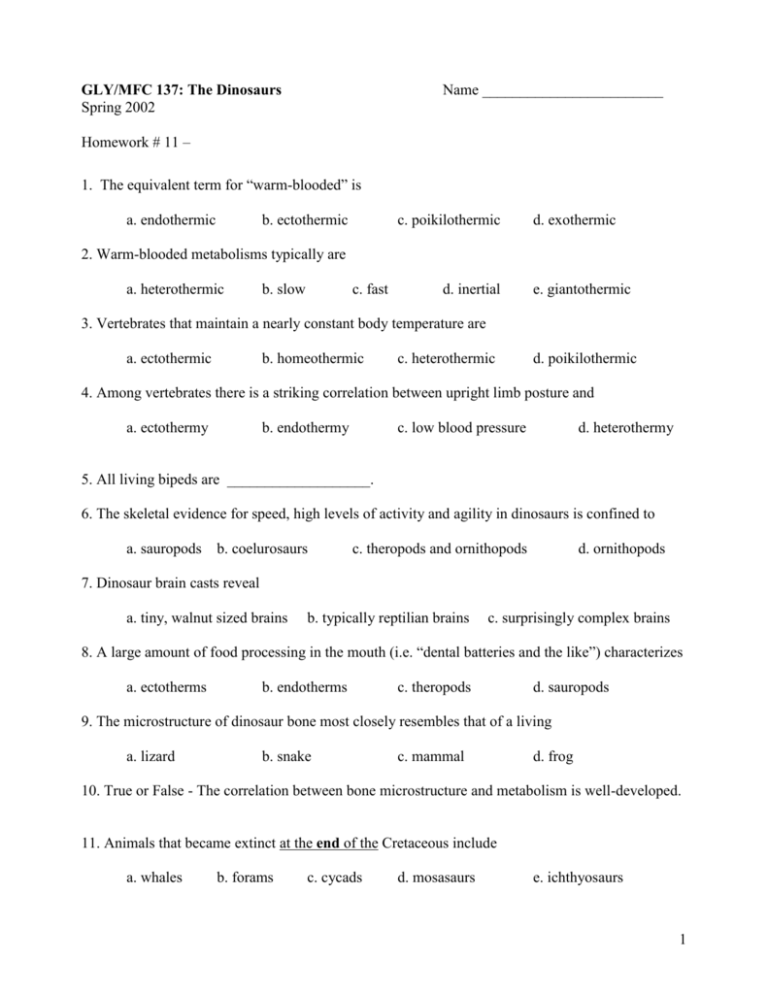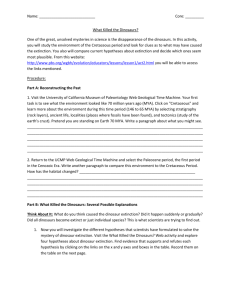Homework 11
advertisement

GLY/MFC 137: The Dinosaurs Spring 2002 Name ________________________ Homework # 11 – 1. The equivalent term for “warm-blooded” is a. endothermic b. ectothermic c. poikilothermic d. exothermic 2. Warm-blooded metabolisms typically are a. heterothermic b. slow c. fast d. inertial e. giantothermic 3. Vertebrates that maintain a nearly constant body temperature are a. ectothermic b. homeothermic c. heterothermic d. poikilothermic 4. Among vertebrates there is a striking correlation between upright limb posture and a. ectothermy b. endothermy c. low blood pressure d. heterothermy 5. All living bipeds are ___________________. 6. The skeletal evidence for speed, high levels of activity and agility in dinosaurs is confined to a. sauropods b. coelurosaurs c. theropods and ornithopods d. ornithopods 7. Dinosaur brain casts reveal a. tiny, walnut sized brains b. typically reptilian brains c. surprisingly complex brains 8. A large amount of food processing in the mouth (i.e. “dental batteries and the like”) characterizes a. ectotherms b. endotherms c. theropods d. sauropods 9. The microstructure of dinosaur bone most closely resembles that of a living a. lizard b. snake c. mammal d. frog 10. True or False - The correlation between bone microstructure and metabolism is well-developed. 11. Animals that became extinct at the end of the Cretaceous include a. whales b. forams c. cycads d. mosasaurs e. ichthyosaurs 1 12. The largest extinction in the history of life on Earth occurred at the end of the a. Permian b. Cretaceous c. Triassic d. Pleistocene e. Cambrian 13. At least _____ % of the families of shelled marine invertebrates became extinct at the end of the Cretaceous a. 5 b. 15 c. 85 d. 90 e. 99 14. Most _____ were not affected by the terminal Cretaceous extinction. a. reptiles b. mammals c. birds d. all of the above e. none of the above 15. The last interval of the Cretaceous time is the a. Montian b. Messinian c. Missourian d. Maastrichtian 16. The two conflicting patterns seen in the latest Cretaceous dinosaurs of western North America result, in part, from a. differing identifications b. differing amounts of collecting c. differing locomotory patterns d. a and b e. b and c 17. A comet/asteroid impact at the end of the Cretaceous apparently left a worldwide layer of rock that is rich in __________________. 18. Quartz grains with laminar deformations generated by high speed shock in laboratories, nuclear test sights and near impact craters are called a. chert b. muscovite c. tektite d. shocked quartz 19. Huge volcanoes were present at the end of the Cretaceous in a. El Salvador b. New Zealand c. India d. Japan 20. Possible effects of a comet/asteroid impact include a. global darkness Bonus b. quartz rain c. supernova d. chronosynclastic infundibulation The comet/asteroid impact theory predicts a. a sudden extinction b. a gradual extinction c. a selective extinction d. no extinction Bonus II Name another theory of what caused dinosaur extinction 2











